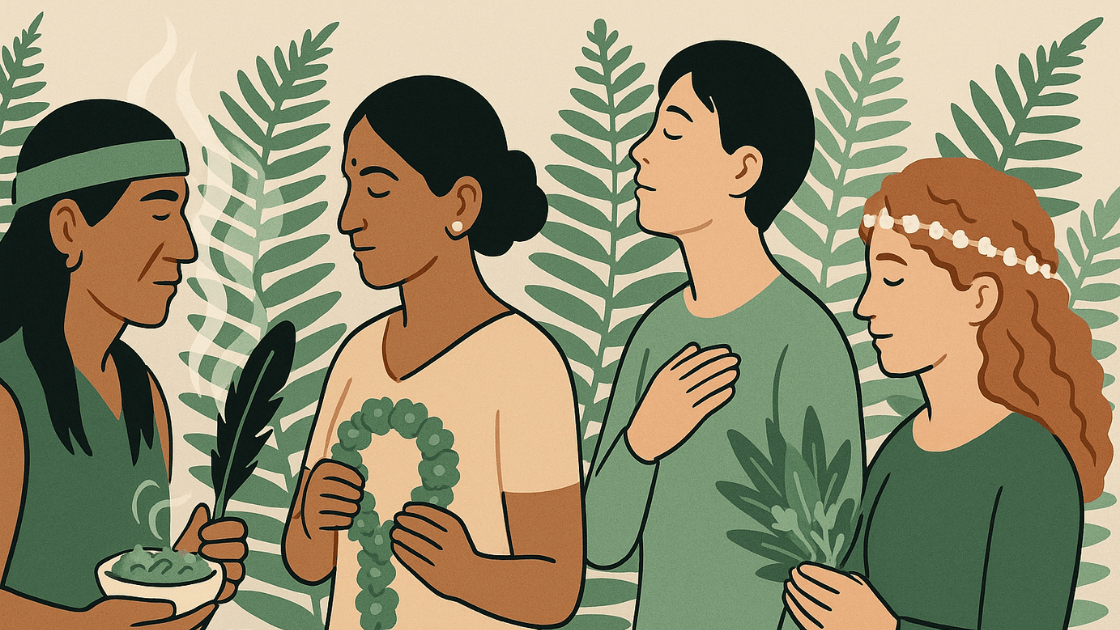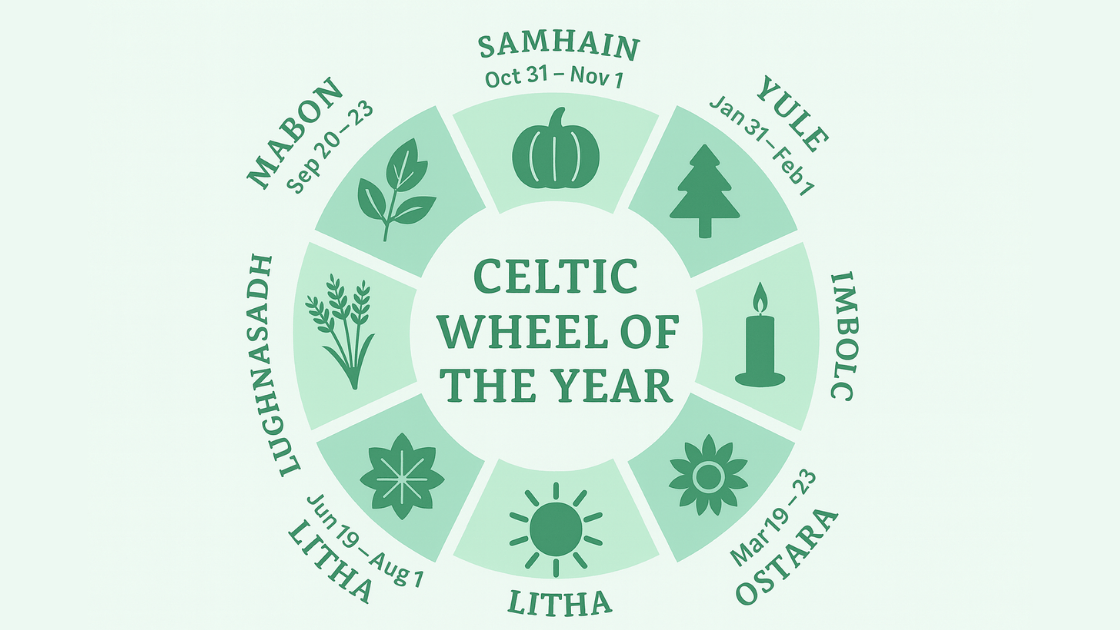
Seasonal healing is deeply rooted in many cultures and indigenous traditions across the world. This topic is so rich and expansive that I’ve decided to write a series here on ‘The Holding Space’ exploring the many aspects of seasonal healing and how different cultures, including our own ancestors, have worked with the Earth’s rhythms.
This first post will explore the rich cultural and historical roots of seasonal healing. We’ll look at how indigenous traditions, ancient medicine systems, and spiritual lineages have aligned with nature for physical health, emotional balance, and spiritual connection. This is just a broad overview, so you’ll find references at the end in case you want to dig deeper.
In the next post, I’ll explore Celtic and European pagan traditions, specifically ‘the wheel of the year’. After that, we’ll dive into Lughnasadh (also known as Lammas), a Celtic holiday that celebrates the first harvest. It’s fast approaching on August 1st. I’ll share ways to celebrate and ritualize it in a modern way. I’m focusing on this part of the series because of my own Scottish and Irish ancestry and my ongoing work of ancestral reclamation.
Why This Matters Now and What It Has to Do with Therapy
Honestly? I believe it has ALOT to do with therapy. I owe much of my exploration of seasonal and ancestral healing to people I’m lucky enough to know both personally and professionally. As one of my dear, straight-to-the-point friends once said, “white people need to explore your own cultures so you stop appropriating and harming ours.”
I’ve been moved by many different activists and humans who continue to inspire me to get my stuff together as a white lady and to recognize that this is lifelong work. As a white American, I believe this journey is necessary, not only to recognize the many privileges and the debts that are owed, but to reclaim the cultural practices we discarded in order to benefit from whiteness. If you have Irish ancestry, and would like to learn more about the topic, I recommend Noel Ignatiev’s book How the Irish Became White.
Also, seasonal healing is not about spiritual bypassing—especially not the kind that shows up in many new age spaces. This is not about love and light while ignoring systems of harm. It’s part of a larger movement to decolonize the ways we approach health, therapy, and even time itself. Dr. Jennifer Mullan, founder of Decolonizing Therapy, teaches that colonization severed many of us from our ancestral knowledge, especially in how we heal emotions and relate to land. She reminds us that intergenerational trauma and systems of oppression often push marginalized communities to be productive year-round.
Seasonal healing invites us to remember. It says we are allowed to slow down in winter, bloom in spring, and rest deeply when we need to. It challenges the idea that wellness should be one-size-fits-all. These ancestral practices are not “alternative.” They are intelligent. They are grounded. And they are alive.
North American Indigenous Traditions
Many Native communities follow seasonal cycles for food, ceremony, and healing. Among the Navajo, Anishinaabe, Lakota, Coast Salish, and many others, the seasons are connected to the four directions, stages of life, and elements of wellness.
- Winter is for introspection, rest, and storytelling
- Spring brings cleansing, planting, and renewal
- Summer is for growth, energy, and celebration
- Fall is a time of gathering and release
Healing practices include sweat lodges, herbal medicine, fasting, ceremony, and deep connection with ancestors and the land.
Traditional Chinese Medicine (TCM)
In TCM, everything is about balance and flow. The five elements and the seasons are tightly linked. Each season is connected to an organ system and a dominant emotion:
- Spring: Liver and anger. A time for cleansing and new beginnings
- Summer: Heart and joy. High energy and outward expression
- Late Summer: Spleen and digestion
- Autumn: Lungs and grief. A time to let go
- Winter: Kidneys and fear. A season for rest and deep reflection
Healing includes acupuncture, seasonal foods, herbal medicine, and daily routines that sync with nature.
Ayurveda (India)
Ayurveda, which means “the science of life,” includes a core seasonal philosophy called Ritucharya—seasonal routine. Each season brings shifts in food, movement, and rest to balance the doshas, or body energies.
- Spring is Kapha season: heavy, wet, cool. Light cleansing and stimulation are key
- Summer is Pitta season: hot and intense. Emphasize cooling foods and calming routines
- Autumn and early winter are Vata seasons: dry, light, and cold. Grounding and warmth support balance
Healing practices include herbs, yoga, oil massage, and rhythm with nature.
Celtic and European Pagan Traditions
The Celtic calendar follows the Wheel of the Year, which includes solstices, equinoxes, and cross-quarter festivals like Samhain, Imbolc, Beltane, and Lughnasadh. Each festival marks a natural shift in light, energy, and mood.
Healing practices involve ritual, herbal medicine, storytelling, and living in harmony with the land. For me, this tradition feels earthy, poetic, and mystical, with a grounded practicality that makes seasonal living feel like home.
Andean Indigenous Traditions (Quechua, Aymara)
In the Andes, people honor Pachamama (Mother Earth) with seasonal offerings. Despacho ceremonies are made with flowers, seeds, food, and prayers. Healing follows agricultural and lunar cycles and includes plant medicine, fasting, and ritual. Dreams and spirits are important guides.
African Traditional Healing
Across many African cultures, healing flows with the land’s cycles. The rainy and dry seasons guide planting, harvesting, and ceremony.
Traditions such as Yoruba, Zulu, and Dagara include herbal remedies, music, divination, spiritual guidance, and ancestral work. Different seasons carry distinct energies and knowing when to act or rest is part of a living tradition passed down through generations.
Māori Traditions (Aotearoa/New Zealand)
The Māori calendar, Maramataka, is both lunar and seasonal. It helps determine ideal times for healing, planting, fishing, and ritual. Traditional healing (Rongoā) includes plant medicine, massage, karakia (prayer), and energy work.
Timing is sacred. Knowing when to begin something matters as much as what you do. This tradition teaches us to live in relationship with the land and the stars.
Japanese Traditions
Japanese culture honors the seasons deeply. Shinto festivals celebrate natural turning points, and Kampo, the traditional medicine system, shifts treatments according to seasonal needs.
One healing practice that blends ancient and modern is shinrin-yoku or forest bathing. It involves slow, mindful time in nature and supports nervous system regulation, especially when practiced in tune with the seasons.
Siberian and Mongolian Shamanism
In these traditions, shamans work closely with the Earth’s cycles. Winter is a time for dreamwork and spirit connection. Summer is for outdoor rituals, fire, drumming, and gathering herbs. The solstices and equinoxes are key times for ceremony, trance journeying, and honoring animal spirits and ancestors.
Balinese and Javanese Traditions (Indonesia)
Healing in Indonesia moves with the wet and dry seasons. Jamu, a traditional herbal tonic, shifts to detox or balance the body depending on the season. Ceremonies use music, offerings, and purification rituals to honor the transitions and prepare for what’s ahead.
Resources and References
North American Indigenous Traditions
- National Library of Medicine. (2011). The Medicine Wheel and the Four Directions
- Cronkite News. (2024). Healing Ourselves as Indigenous People
- Indigenous Healing Traditions
Māori Maramataka and Rongoā
Andean Traditions
Decolonizing Therapy by Dr. Jennifer Mullan

